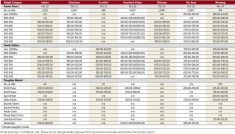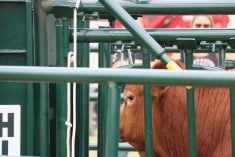Keeping track of a bull’s breeding soundness exam results over the years can pay big farm planning dividends, but when it comes to the first one, there are a couple of things to keep in mind.
Alberta veterinarian Dr. Roy Lewis had some advice for evaluating young bulls during a recent webinar hosted by the Beef Cattle Research Council.
Why it matters: Jumping the gun on the first breeding soundness exam might lead to poor results.
Read Also

Three paths of rengerative agriculture
From integrating livestock to grassland financial incentives to precision grazing, Canadian farmers are searching for practical paths to marry farm resilience with profit
The first, most obvious step — and one Lewis says the purebred sector typically does very well — is the initial selection for things like temperament and physical attributes.
“I’m always watching the bulls’ feet and legs,” said Cody Nolan, manager of the Manitoba Bull Test Station in Douglas, Man. “If there’s something that I don’t like that they’re going to pass onto their calves…I pull them.”
The later veterinary visit to test semen doubles down on those findings.
When it comes to collecting semen samples, however, Lewis warned the sector not to be too hasty in getting the animal in the chute.
One year is the absolute minimum age for semen testing, he said. Older is better.
“Breeders will bring through their main bull battery and all of a sudden I’ll get one who isn’t reacting quite right and I’ll say, ‘How young is this bull?’ And sure as heck, he’ll be 11 and a half months old,” Lewis said.
And while 12 months is his line in the sand, “13 is better than 12,” he said. “Fourteen is better than 13 and 15 is quite a bit better.”
Producers might be risking under evaluating things like scrotal measurements if they evaluate a bull too young. Scrotal size at 10 months will be a very different thing than at 15 months, according to Lewis.
“They can be growing a couple of centimetres a month,” he said. “It can make a big difference if you’re trying to compare a 13-month to a 15-month-old bull.”
Nolan echoed Lewis’s preferred evaluation window.
“When we’re semen testing here, our sale is the end of March,” he said. “Typically, the bulls that I see fail are March-born bulls that are just a year old. They’re just failing on immaturity.
“Those bulls, in a couple of months, two months, they’ll pass with flying colours.”
Motility
A young animal also has considerations with motility, or the ability of sperm to move efficiently, Lewis said.
Activity spurs motility, he said — something a young bull is lacking.
“It’s basically just dead sperm that have been sitting there,” he said.
“Young bulls, it’s the fact that, again, they haven’t been that active. They’re not riding. They’re kind of sexually still reaching maturity.”
Most of the time, barring an issue with actual sperm production, usage will help improve motility. Just the process of collecting a semen sample can start that process, since it stimulates fresh sperm, Lewis said.
Mature bulls coming off a period of inactivity can have a similar issue, he also noted, while some bulls will just produce more dead semen as a matter of course through their lives.
Infection
A bull coming into the evaluation with a high white blood cell count might need to be re-tested.
Lewis pointed to infection in the seminal vesticles, which causes pus to make its way into the semen. Unless the case is severe, he noted, the issue will often be only flagged by the vet technician when analyzing the semen sample.
Those infections may clear up, whether with or without antibiotic intervention, he said, but either way, the bull will need at least two weeks, and “preferably three or four” before being retested.
In reality, however, there is pressure to re-test before that window, due to the time crunch around the sale season, he said.
















